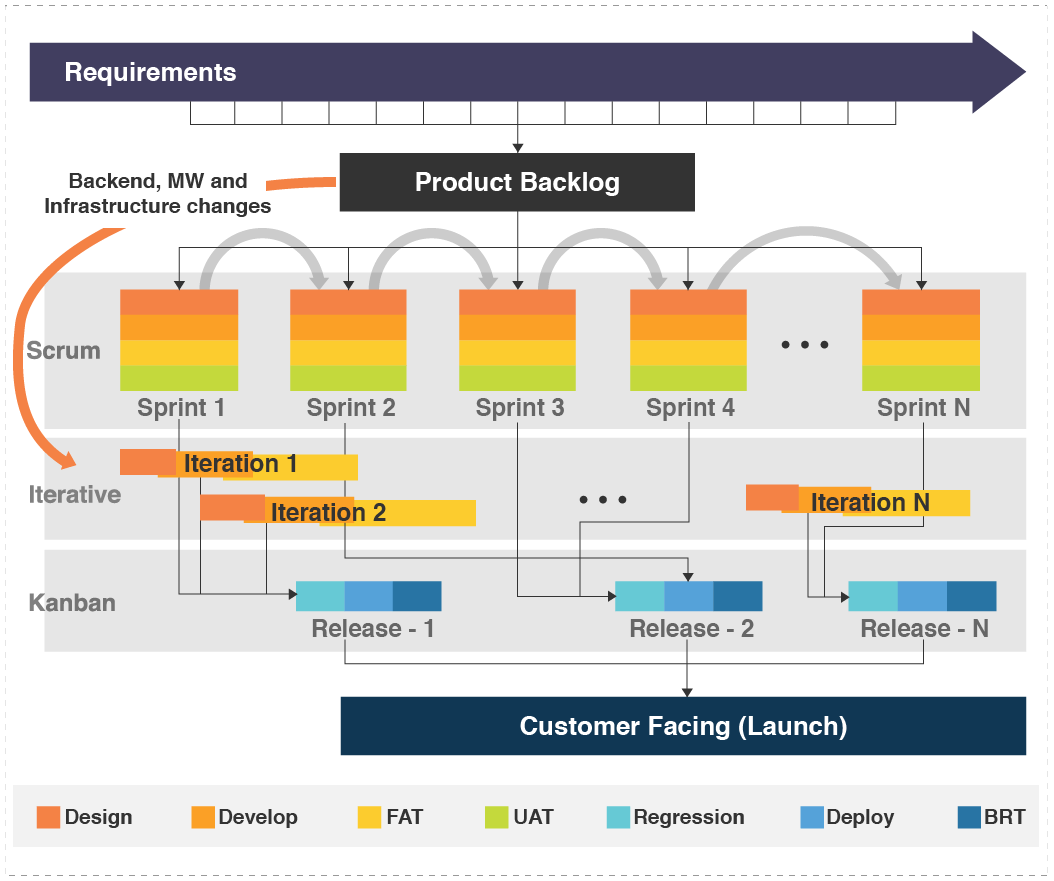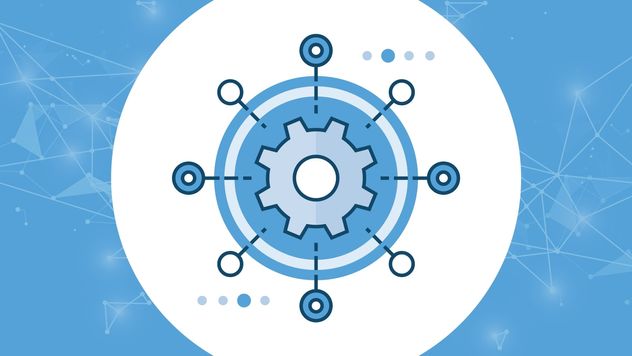
Depending on which study you read, you’ll find failure rates for large IT projects range anywhere from 30 to 90 percent. Whatever the number, it is an astonishing figure considering the strategic importance of many IT initiatives in today’s world. Which begs the question – how can you improve project management and create a scalable framework by utilizing the best attributes of the Agile and Waterfall methodologies?
Let’s take a look together.
Agile and Waterfall—Preeminent Management Methodologies
Project management is difficult, even under the best conditions, with software development projects potentially offering the greatest challenge. Neither business needs nor technology stop evolving, which means projects need to be managed in a highly fluid environment. That’s why it’s vital for your development teams to have a well-defined project methodology in place. By following a structured and scalable framework, project managers can effectively manage the complexity and variability of IT systems as well as the software application(s) being developed. This serves to drive benchmark success and reduce the risk of costly rework.
Two of the most popular project management methodologies are Agile and Waterfall. Both of these are solid, mature methodologies and are popular for diverse reasons. When it comes to choosing between the two, neither is inherently better than the other; rather, it is the project itself and the team that is executing it, that should dictate which methodology is selected.
In choosing between Agile and Waterfall, consider the situation, tactical goals, the composition of your team, and your culture. Even if your organization supports a particular model, there are usually opportunities to enhance your chosen method. You should tweak or blend the two methodologies to align with your unique needs, handle new challenges, and keep pace with the larger mandate.
To clarify the opportunities and obstacles of both Agile and Waterfall, let’s begin with a deeper dive into each.
The Agile Model
Agile development uses an iterative, incremental approach that emphasizes the rapid delivery of an application in complete and functional components. If all planned work for the project cannot be completed in the current cycle, work is reprioritized, and the information is used for future iterations or “sprint” planning.
Agile practices are best suited to projects that require constant improvements and need the flexibility to adapt to the varying requirements. As tasks are groomed, they can be evaluated by both your development team and the client in order to amend and meet the changing requirements. The multiple development cycles can be executed, with deliverables prioritized by business value.
The objective of each cycle is to deliver a shippable product that can be demoed to provide feedback and shown as evidence of progress. Any recommendations are directed to future iterations. Agile offers the prospect of ongoing improvement and is highly flexible. In today’s fluid market, where software development needs to be fast and efficient, Agile offers an attractive option.
- Speed: Working software can be delivered quickly and at a consistent pace.
- Flexibility: The process adapts to changes as they occur, which allows for immediate client and end-user feedback that can be used in the next iteration.
- Predictability: Since every cycle is of a fixed-time period, project timelines are easier to predict.
- Value-focused: Development is often more value-focused, which helps fulfill specific end-user needs.
- Continuous testing: Testing is needed throughout the project, which can stretch resources and increase costs if not complemented by continuous integration and automation testing.
- Frequent collaboration: Active customer involvement can add to implementation time and expense if processes are not adapted across your organization.
- Scope definition complexity: The iterative nature of Agile development can create complications in defining the project scope if iteration goals are not defined properly.
- Self-organized team: Team members need to possess and exercise multiple skill sets to help each other and remove internal impediments as much as possible.
The following visual demonstrates key recommendations to overcome the aforementioned challenges

how we mentor and remove impediments because we have
1. Manageable Team size. 2. Single funnel and decision making. 3. automation and seamless integration. 4. collaboration. 5. self organising team. 6. time bound cycle. 7. tool. 8. quick daily update.
The Waterfall Method
Known as the traditional method of software development, the Waterfall approach is a fixed, linear methodology that comprises sequential Systems Development Life Cycle (SDLC) phases. Since each phase is sequential, after a step is completed, rework is typically required to enable your developers to revisit an earlier step to alter the project or its direction.
The methods linear approach makes it simpler to manage and understand. Projects with established requirements to deliver new product(s) with multiple dependencies are good candidates for the Waterfall method.
However, because of the Waterfall methods rigid structure and strict controls, there is little room for modification or error on the part of your team. Therefore, a project acceptance criterion and a detailed plan must be established from the start and followed carefully.
- Well-documented: Each phase calls for comprehensive documentation, which makes it easier to leverage code of previous projects and develop a solid base for upcoming projects.
- Firm deadlines: A defined starting point and a fixed evaluation process for each phase make it easier to estimate costs and meet timelines.
- Well-organized: Clearly defined projects with sequential workflows help simplify status updates to all your project stakeholders.
- Difficult to modify: Since testing and feedback don’t occur until late in the project, modifications and improvements can be complex and costly to implement.
- Lack of foresight: Since requirements are often unknown when a project is initiated, designers can’t always foresee problems that may arise out of the implementation process. Thus, Waterfall requires that key team members—and especially the project manager—have worked in similar circumstances.
- Delivery speed: Due to the sequential approach, your team can’t produce a shippable product until all project phases (SDLC) are completed.
Evaluating Best-Fit Project Types
With its linear model and clear specifications, it might seem that Waterfall may require less time with better control compared to Agile. This is accurate to some degree. However, with Agile and Automation Testing, products can be launched anytime, helping to accelerate time-to-market and revenue generation.
In terms of evaluating between Agile and Waterfall, neither is intrinsically superior. Depending on the scope, structure and scale of your software project, you’ll usually find one methodology more relevant and useful than the other in specific scenarios. The characteristics of a project help determine which methodology will work best.
Choose Agile when:
- Minimum Viable Product (MVP) is more pressing than product completeness.
- Clients have the opportunity to revise the project scope of future deliverables based on market condition and response.
- You have flexible and expert developers who can think independently.
- The product is planned for a market with rapidly evolving requirements or standards.
Choose Waterfall when:
- The end product design and features are clearly defined and determined.
- Clients have a clear vision and are not expecting to modify the project scope drastically once it has commenced.
- Product completeness, rather than speed to market, is vital to success.
Optimizing Your Return on Investment
While the idea of following a designated methodology for completing a project makes sense, what happens when your unique project requires elements from both Agile and Waterfall? Simple, you take the best of both worlds and use a hybrid model. For example, we have used agile sprint-based development in Waterfall methodology and it has provided our team with the opportunity to review the outcome after every short cycle of development.
Ultimately, understanding the opportunities and obstacles of these methods will make you and your team better equipped to implement a scalable framework to deliver complex IT systems that meet sustainable growth. Here at mobileLIVE, we’ve successfully delivered hundreds of projects using a combination of Iterative Waterfall, Scrum, and Kanban methodologies, all tailored to the clients’ unique needs.

The above image clearly demonstrates the scalable approach by leveraging the three methodologies namely Iterative Waterfall, Scrum, and Kanban. At the time of backlog grooming, the stories are assessed, and right methodologies are chosen to develop the enablers
Remember, while the method in which a project is executed is critical, ultimately what really matters is winning business and consistently delivering high-value software that meets end-user performance demands. Reach out to us today and learn how we’ve helped our clients streamline development without sacrificing on value for the end-user, all the while exceeding quality, one time, on budget – every time!
Interested in learning which approach is right for you? Let’s Connect



